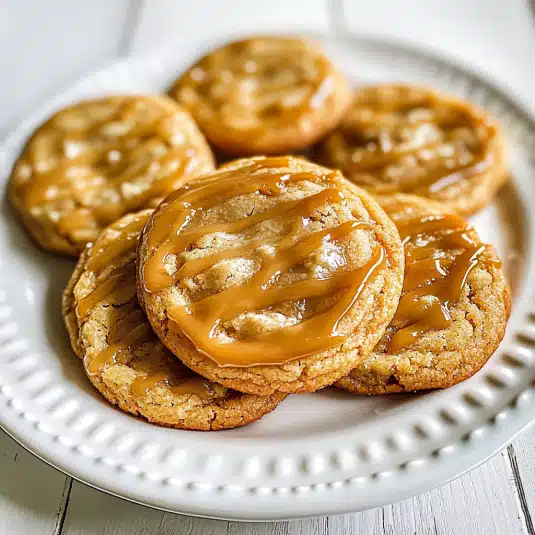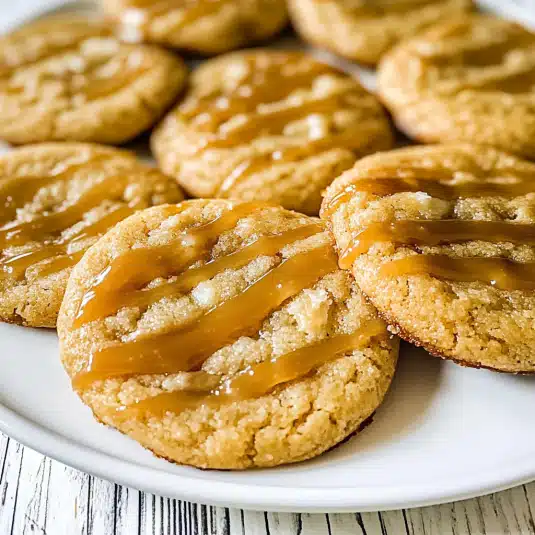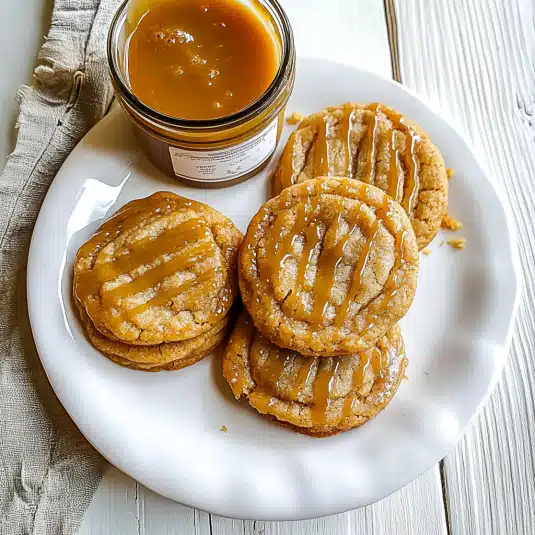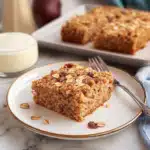There’s nothing like biting into a warm, soft caramel cookie that melts in your mouth. If you’ve been searching for the perfect caramel cookie recipe, you’re in the right place. This guide doesn’t just hand you one good recipe. It gives you everything you need to master caramel cookies in your own kitchen.

We’ll show you three proven methods to add caramel to cookies, each with its own benefits. You’ll learn which method gives you the gooey center, which one is easiest, and which one delivers the richest flavor. Whether you’re baking for fun, gifting, or perfecting your cookie game, this is the only caramel cookie guide you’ll ever need.
Table of Contents
Why This is the Best Caramel Cookie Recipe
- Truly soft and chewy every time
- Rich caramel flavor that comes from real caramel, not just sugar
- Multiple methods explained so you can choose the one that works best for you
- Step-by-step guidance to prevent caramel from burning or leaking out
- Uses simple ingredients that are easy to find at any grocery store
- Includes expert tips and fixes for flat, crumbly, or overbaked cookies
- Offers options for salted caramel, mix-ins, and freezer-friendly prep
- Designed for all skill levels, from beginners to seasoned bakers
The Secret to Perfect Caramel Cookies: Key Ingredients
Understanding your ingredients is the first step to making caramel cookies that taste incredible and bake perfectly every time. Here’s what really matters.
1. Choosing Your Caramel (The Most Important Step)
The type of caramel you use changes everything. Each kind behaves differently in the oven.
Caramel Bits
These are tiny caramel pieces that mix easily into the dough. They hold their shape while baking, so they don’t melt out. They’re great for beginner bakers and perfect if you want cookies that stack neatly.
Soft Caramels (Squares)
These create gooey, molten centers when added correctly. You need to press them into the cookies right after baking or wrap the dough around small pieces before baking. The payoff is amazing texture, but they require more attention.
Caramel Sauce
This adds flavor to the dough itself but won’t give you chewy caramel pockets. It’s a good choice if you want an overall caramel taste, but don’t expect gooey bites. It can also make the dough too soft if not balanced properly.
2. Dark vs. Light Brown Sugar
Brown sugar adds moisture and chewiness to cookies. The darker the sugar, the more molasses it contains.
Dark Brown Sugar
This is your best bet for soft, chewy caramel cookies. It has a deeper flavor and creates a richer, more satisfying texture. It also helps the cookies stay soft longer.
Light Brown Sugar
Still good, but the flavor is milder. Use it if you prefer a lighter cookie or if that’s what you already have at home.

The 3 Best Ways to Make Caramel Cookies (Pros and Cons)
Most caramel cookie recipes use just one method. This guide gives you all three, so you can choose the one that fits your time, taste, and texture goals.
Method 1: The Mix-In (Easiest and Best for Gifting)
This method is straightforward. You simply stir caramel bits into the dough before baking.
Pros:
- Quick and simple
- No extra steps after baking
- Cookies come out clean and stackable, perfect for storing or gifting
Cons:
- Less gooey texture
- Caramel flavor stays more subtle
Method 2: The Stovetop-Toffee (Richest Flavor)
You cook a quick caramel on the stovetop, then mix the dry ingredients directly into the hot caramel mixture to form the dough.
This advanced method requires a different recipe. Here’s how:
Stovetop-Toffee Caramel Cookies (Makes 24 cookies)
Ingredients
- 1 cup unsalted butter
- 1 and 1/4 cups dark brown sugar
- 2 tablespoons water
- 1 teaspoon vanilla extract
- 2 and 1/4 cups all-purpose flour
- 1/2 teaspoon baking soda
- 1/2 teaspoon salt
Instructions
- In a saucepan, melt butter and brown sugar over medium heat, stirring constantly. Add water and bring to a gentle simmer for one minute. Remove from heat.
- Stir in vanilla and let the mixture cool for 5 to 7 minutes.
- In a separate bowl, whisk flour, baking soda, and salt.
- While the caramel is still warm (not hot), mix in the dry ingredients until combined.
- Scoop dough into balls and place on lined baking sheet.
- Bake at 350°F for 8 to 10 minutes. Let rest for 5 minutes before transferring.
Pros:
- Deep, bold caramel flavor throughout the cookie
- Gives the cookie a slightly crisp edge with a soft center
Cons:
- Timing matters, and the dough can harden quickly if you wait too long
- Slightly more effort and cleanup required
Method 3: The Post-Bake Press (Gooey-est Result)
Bake your cookies normally, then press a small piece of soft caramel into the center as soon as they come out of the oven.
Pros:
- Creates a gooey, melt-in-the-middle effect
- Visually appealing with shiny caramel centers
Cons:
- Messier to eat and harder to store
- Not ideal for stacking or packing in bags
Choose the method that matches your needs. For everyday baking, the mix-in works well. For flavor depth, go with the stovetop. If you want maximum gooeyness, try the post-bake method.
Use the master recipe above, but substitute 1 and 1/4 cups of caramel chips for 24 soft caramel pieces. Do not add them to the batter. Instead, press one piece into the center of each cookie immediately after it comes out of the oven.

How to Make Caramel Cookies (Our Recommended Method)
For the perfect balance of flavor, texture, and ease, we recommend the Mix-In Method using caramel bits. It’s simple, beginner-friendly, and delivers soft, chewy cookies with a rich caramel taste.
Equipment Needed
- Mixing bowls
- Hand or stand mixer
- Rubber spatula
- Baking sheet
- Parchment paper or silicone baking mat
- Cookie scoop or tablespoon
- Cooling rack
Ingredients
- 1 cup unsalted butter, softened
- 1 and 1/4 cups dark brown sugar
- 1/2 cup granulated sugar
- 2 large eggs
- 2 teaspoons vanilla extract
- 2 and 3/4 cups all-purpose flour
- 1 teaspoon baking soda
- 1/2 teaspoon salt
- 1 and 1/4 cups caramel bits
Step-by-Step Instructions
- Preheat the oven to 350°F and line your baking sheet with parchment paper.
- Cream the butter and sugars together in a large bowl until light and fluffy, about 2 minutes.
- Add the eggs and vanilla, mixing until smooth.
- In a separate bowl, whisk together the flour, baking soda, and salt.
- Gradually mix the dry ingredients into the wet mixture until just combined.
- Fold in the caramel bits using a spatula or wooden spoon.
- Scoop the dough into balls and place them on the prepared baking sheet, spacing them about 2 inches apart.
- Bake for 9 to 11 minutes, or until the edges are lightly golden but the centers still look soft.
- Let the cookies rest on the pan for 5 minutes before moving them to a cooling rack.
The result is a batch of perfectly chewy caramel cookies with just the right amount of sweetness and soft centers.
Recipe Variations
Caramel cookies are flexible and easy to customize. Whether you prefer a touch of salt or want to add texture and flavor, these variations can help you make the recipe your own.
How to Make a Small Batch (12 Cookies)
To make a small batch of 12 cookies, simply divide all ingredients in the recipe card in half. Baking time will remain approximately the same.
How to Make Salted Caramel Cookies
After baking, immediately sprinkle a pinch of flaky sea salt on each cookie while they’re still warm. This small step balances the sweetness and adds a little crunch. It also captures that popular sweet and salty combo without changing the base recipe.
Popular Add-Ins
Want to mix things up? Try adding one or more of these ingredients to your dough before baking.
White Chocolate Chips
Sweet and creamy, they pair well with caramel for a rich, buttery bite.
Semi-Sweet Chocolate Chips
These add contrast and depth, cutting through the sweetness of the caramel.
Toasted Pecans
They bring a slight crunch and a nutty flavor that complements the softness of the cookies.
These extras are optional, but they can elevate your cookies with very little effort.
Troubleshooting and Expert Tips
Even the best cookie recipes can go wrong without the right tips. This section helps you fix common issues before they ruin your batch.
Tip 1: Don’t Overbake
The cookies should look slightly underdone in the center when you take them out. They will finish cooking as they cool on the baking sheet.
Why did my caramel melt and burn?
This usually happens when the caramel is too soft or the oven is too hot. Caramel bits hold their shape better. If using soft caramels, try pressing them in after baking rather than baking them inside the dough.
Why is my dough crumbly?
This is often caused by too much flour or letting stovetop caramel dough cool too long before mixing. Always measure flour correctly and work quickly with stovetop methods.
Why are my cookies flat?
The butter may have been too warm, or the dough might have needed chilling. To avoid flat cookies, chill the dough for 20 minutes before baking, especially if your kitchen is warm.
How to Store, Freeze, and Make Ahead
Planning ahead or saving extras? These tips will keep your caramel cookies fresh and delicious.
Storing Baked Cookies
Store cooled cookies in an airtight container at room temperature. They’ll stay soft for up to five days. Add a slice of bread to the container to help maintain moisture.
Freezing Cookie Dough
Scoop the dough into balls and place them on a tray. Freeze for about one hour, then transfer to a zip-top freezer bag. Label and date the bag. The dough will stay good for up to three months. When ready to bake, place the frozen dough on a tray and bake directly without thawing. Just add one or two extra minutes to the bake time.
Freezing Baked Cookies
Let cookies cool completely, then place them in a single layer inside a freezer-safe bag or container. Use parchment between layers if stacking. To serve, let the cookies come to room temperature or warm them slightly in the microwave.
Conclusion
Caramel cookies should be soft, chewy, and full of flavor. This guide gives you all the tools to make that happen. Whether you want something quick and giftable or rich and gooey, one of the three methods here will work for you. Each approach has been tested for flavor, texture, and ease.
This recipe stands out because it explains the why, not just the how. From choosing the right caramel to fixing flat cookies, you get everything in one place. You also get options for freezing, storage, and fun add-ins.
Tried the recipe? Leave a comment and a star rating below. Share your results on Pinterest or Facebook. What variation did you try? Soft caramels, toasted pecans, or something completely new? Let us know.
Fore more recipes follow me in Facebook, medium and Pinterest
Print
Caramel Cookies
- Total Time: 25 minutes
- Yield: 24 cookies 1x
- Diet: Vegetarian
Description
Soft, chewy caramel cookies packed with rich flavor and gooey texture. Perfect for everyday baking, holiday gifting, or sweet cravings anytime.
Ingredients
- 1 cup unsalted butter, softened
- 1 and 1/4 cups dark brown sugar
- 1/2 cup granulated sugar
- 2 large eggs
- 2 teaspoons vanilla extract
- 2 and 3/4 cups all-purpose flour
- 1 teaspoon baking soda
- 1/2 teaspoon salt
- 1 and 1/4 cups caramel bits
Instructions
- Preheat the oven to 350°F and line your baking sheet with parchment paper.
- Cream the butter and sugars together in a large bowl until light and fluffy, about 2 minutes.
- Add the eggs and vanilla, mixing until smooth.
- In a separate bowl, whisk together the flour, baking soda, and salt.
- Gradually mix the dry ingredients into the wet mixture until just combined.
- Fold in the caramel bits using a spatula or wooden spoon.
- Scoop the dough into balls and place them on the prepared baking sheet, spacing them about 2 inches apart.
- Bake for 9 to 11 minutes, or until the edges are lightly golden but the centers still look soft.
- Let the cookies rest on the pan for 5 minutes before moving them to a cooling rack.
Notes
Chill the dough for 20 minutes before baking if your kitchen is warm. Sprinkle flaky sea salt on top after baking for a salted caramel version. Add-ins like white chocolate chips, semi-sweet chips, or toasted pecans elevate the flavor.
- Prep Time: 15 minutes
- Cook Time: 10 minutes
- Category: Dessert
- Method: Baking
- Cuisine: American
Nutrition
- Serving Size: 1 cookie
- Calories: 174 kcal
- Sugar: 9 g
- Sodium: 182 mg
- Fat: 9 g
- Saturated Fat: 5 g
- Carbohydrates: 21 g
- Protein: 1 g
- Cholesterol: 24 mg
Frequently Asked Questions (FAQ)
What causes caramel to crystallize?
Crystallization happens when sugar molecules group together instead of melting smoothly. Stirring too much or using utensils with leftover sugar can trigger this. To avoid it, use clean tools and let the sugar melt slowly without agitation.
What are common caramel mistakes?
Using high heat, over-stirring, or skipping a candy thermometer can lead to burnt or grainy caramel. Another mistake is using the wrong caramel type for baking, which can cause melting or leaking.
Why does my homemade caramel taste bitter?
Burnt caramel is the most common reason. This happens when the sugar cooks too long or the heat is too high. Always watch closely and remove from heat once it reaches a medium amber color.
What is the difference between wet and dry caramel?
Wet caramel starts with sugar and water, which makes it slower to cook but easier to control. Dry caramel uses only sugar and melts faster but can burn quickly. Wet caramel is better for beginners or for recipes that need more moisture.
What makes cookies more chewy?
Chewy cookies need more moisture. Using dark brown sugar, real butter, and slightly underbaking the cookies helps. Avoid overmixing and always measure your flour correctly.
What makes caramel hard or soft?
The final temperature of the cooked sugar determines texture. Lower temperatures give soft, stretchy caramel. Higher temperatures create firm or hard caramel. Using cream or butter also affects softness.




